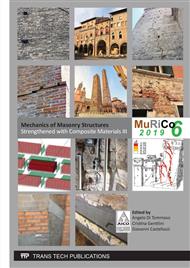p.3
p.9
p.15
p.23
p.30
p.37
p.44
p.50
Numerical Modelling of the Tensile Behaviour of BFRCM Strips
Abstract:
This paper aims at investigating the tensile behaviour of basalt fibres on cementitious matrix for the strengthening of masonry structures. The use of Basalt Fibre Reinforced Cementitious Matrix (BFRCM) is favourably considered by the scientific community because it represents a natural composite material with high compatibility with stone and masonry substrate. The study is developed through the generation of Finite Element (FE) models capable of reproducing the tensile behaviour of BFRCM strips with different number of layers of grid. For the scope, the micro-modelling approach is adopted assuming different levels of detail for the simulation of the interface constitutive behaviour. Fibre and substrate are modelled separately and the interface between the two components is simulated by introducing numerical contact properties for reproducing the perfect bond condition, on one hand, and the cohesive tangential slip, on the other hand. The damage of the composite system is investigated using proper damage numerical models at the interface.
Info:
Periodical:
Pages:
15-22
Citation:
Online since:
August 2019
Keywords:
Price:
Сopyright:
© 2019 Trans Tech Publications Ltd. All Rights Reserved
Share:
Citation:


